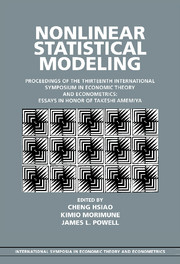 Nonlinear Statistical Modeling
Nonlinear Statistical Modeling Book contents
- Frontmatter
- Contents
- Series editor's introduction
- Editors' introduction
- Contributors
- 1 Local instrumental variables
- 2 Empirically relevant power comparisons for limited-dependent-variable models
- 3 Simulation estimation of polychotomous-choice sample selection models
- 4 A new approach to the attrition problem in longitudinal studies
- 5 Semiparametric estimation for left-censored duration models
- 6 Semiparametric estimation of censored selection models
- 7 Studentization in Edgeworth expansions for estimates of semiparametric index models
- 8 Nonparametric identification under response-based sampling
- 9 On selecting regression variables to maximize their significance
- 10 Using information on the moments of disturbances to increase the efficiency of estimation
- 11 Minimal conditions for weak convergence of the sample standardized spectral distribution function
- 12 Unit root tests for time series with a structural break when the break point is known
- 13 Power comparisons of the discontinuous trend unit root tests
- 14 On the simultaneous switching autoregressive model
- 15 Some econometrics of scarring
- 16 A censored switching regression approach to evaluating the effect of sunk costs and firm-level disequilibrium on export performance
- Curriculum vitae of Takeshi Amemiya
- Index
4 - A new approach to the attrition problem in longitudinal studies
Published online by Cambridge University Press: 05 June 2012
- Frontmatter
- Contents
- Series editor's introduction
- Editors' introduction
- Contributors
- 1 Local instrumental variables
- 2 Empirically relevant power comparisons for limited-dependent-variable models
- 3 Simulation estimation of polychotomous-choice sample selection models
- 4 A new approach to the attrition problem in longitudinal studies
- 5 Semiparametric estimation for left-censored duration models
- 6 Semiparametric estimation of censored selection models
- 7 Studentization in Edgeworth expansions for estimates of semiparametric index models
- 8 Nonparametric identification under response-based sampling
- 9 On selecting regression variables to maximize their significance
- 10 Using information on the moments of disturbances to increase the efficiency of estimation
- 11 Minimal conditions for weak convergence of the sample standardized spectral distribution function
- 12 Unit root tests for time series with a structural break when the break point is known
- 13 Power comparisons of the discontinuous trend unit root tests
- 14 On the simultaneous switching autoregressive model
- 15 Some econometrics of scarring
- 16 A censored switching regression approach to evaluating the effect of sunk costs and firm-level disequilibrium on export performance
- Curriculum vitae of Takeshi Amemiya
- Index
Summary
Introduction
This chapter proposes a new approach to tackling attrition problems in panel studies. Panel data are obtained by observing cross-sectional units such as individuals or households more than once over an extended period of time. Panel data sets are typically unbalanced due to attrition. In the first year of a panel survey, researchers pay full attention to making the sample as representative as possible. Therefore, the first year observations can be regarded as forming a random sample, able to represent the underlying population. However, over time, initial cross-sectional units are dissipated, possibly in a nonrandom fashion. Attrition may negate the initial randomization. If the variable of interest is stochastically related to the factors governing attrition process, then the attrition is nonrandom and potentially causes bias. In this sense, attrition bias can be regarded as a sample selection bias. A major difference between the attrition bias and the typical sample selection bias is that the attrition occurs through a multistage process.
Fuller and Battese (1974), Biørn (1981), Baltagi (1985), and Wansbeek and Kapteyn (1989) have discussed incomplete panel data models, with data unbalanced due to attrition. However, they all assumed that the attrition process is exogenous, and thus assumed away the possible attrition bias.
Attrition bias in panel studies was first considered by Hausman and Wise (1979) using a random effects model for the individual response. The existence of attrition bias was postulated as due to nonrandomness of the remaining crosssectional units after the initial survey years. In other words, attrition bias is simply a sample selection bias.
- Type
- Chapter
- Information
- Nonlinear Statistical ModelingProceedings of the Thirteenth International Symposium in Economic Theory and Econometrics: Essays in Honor of Takeshi Amemiya, pp. 119 - 144Publisher: Cambridge University PressPrint publication year: 2001
- 1
- Cited by


